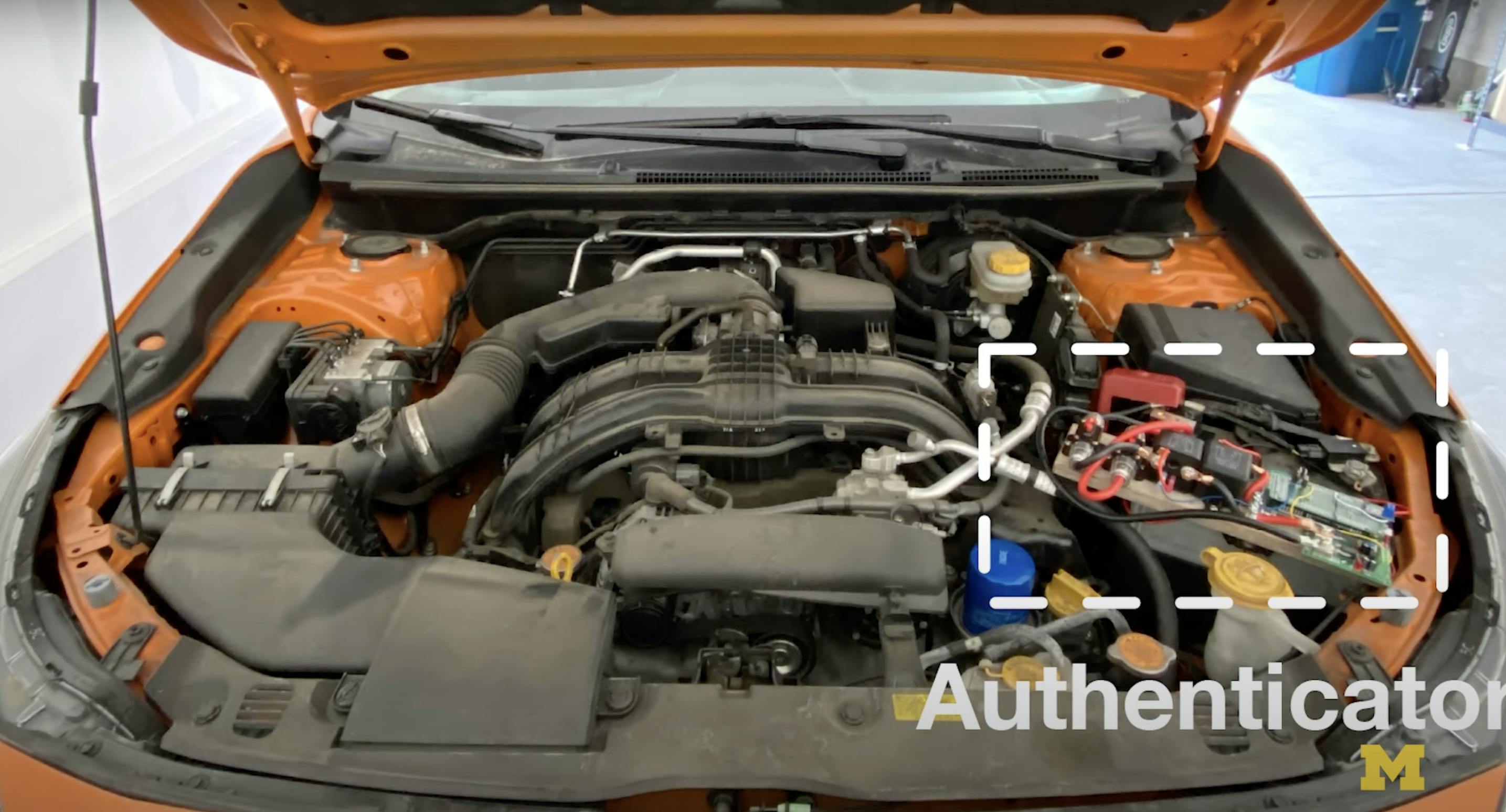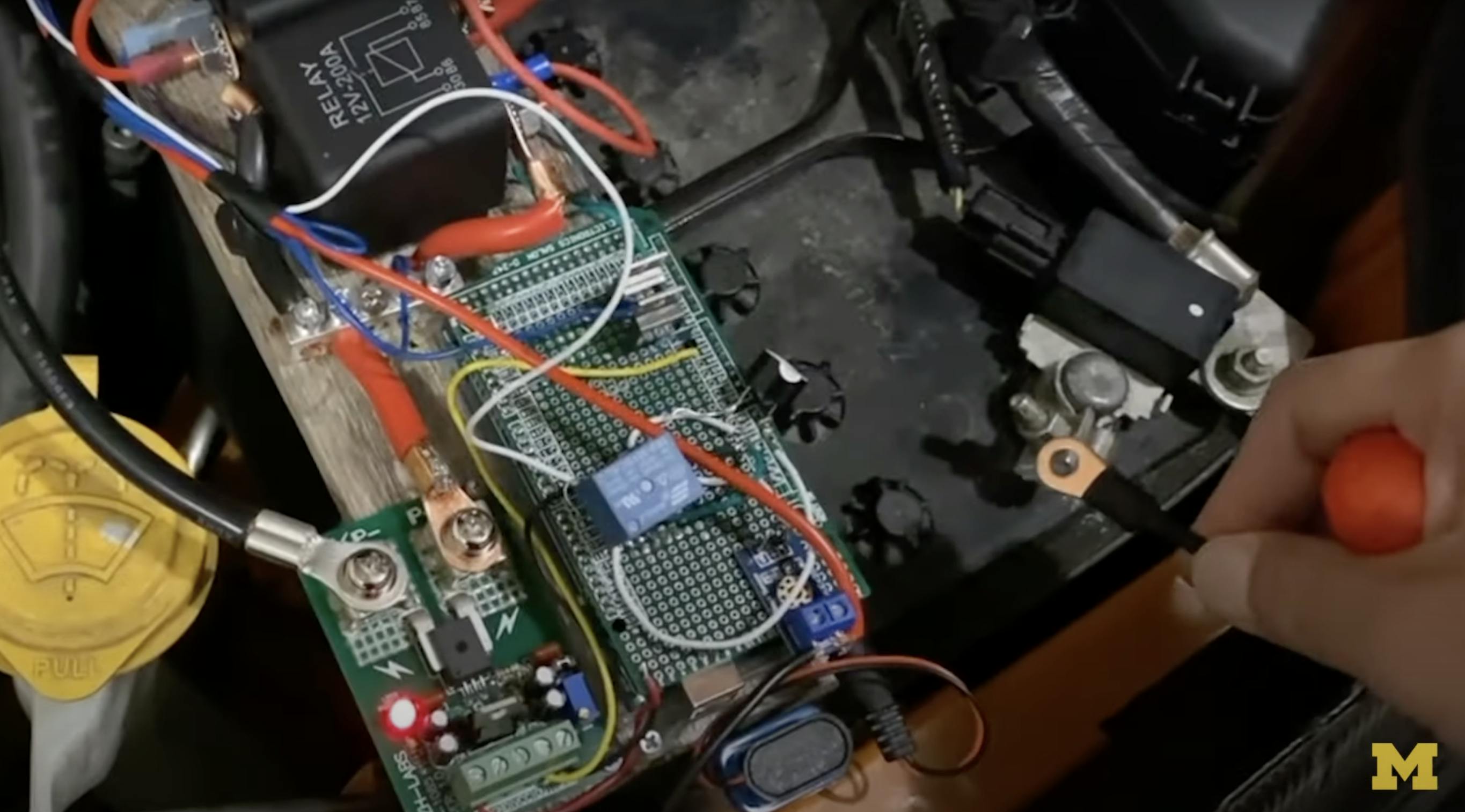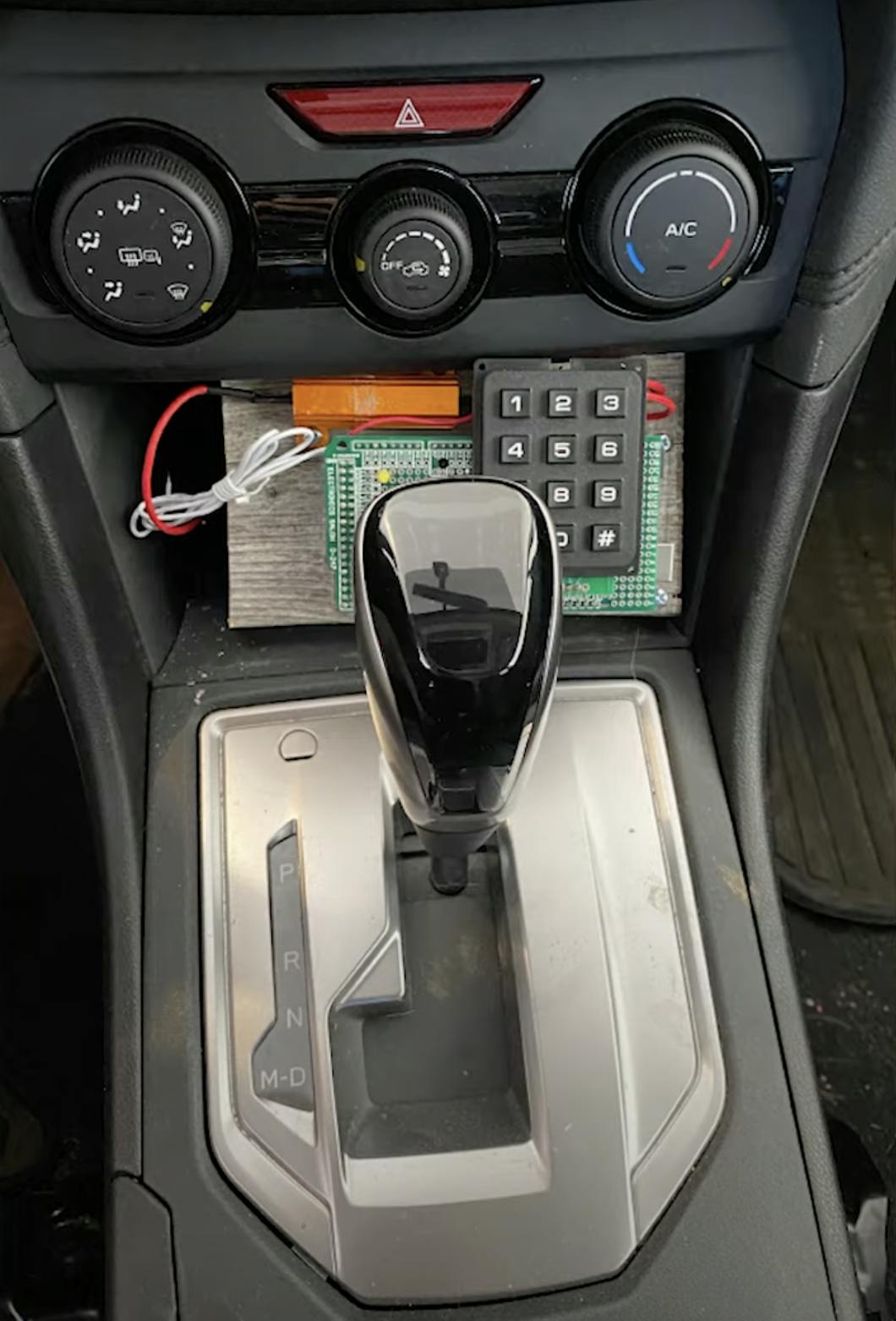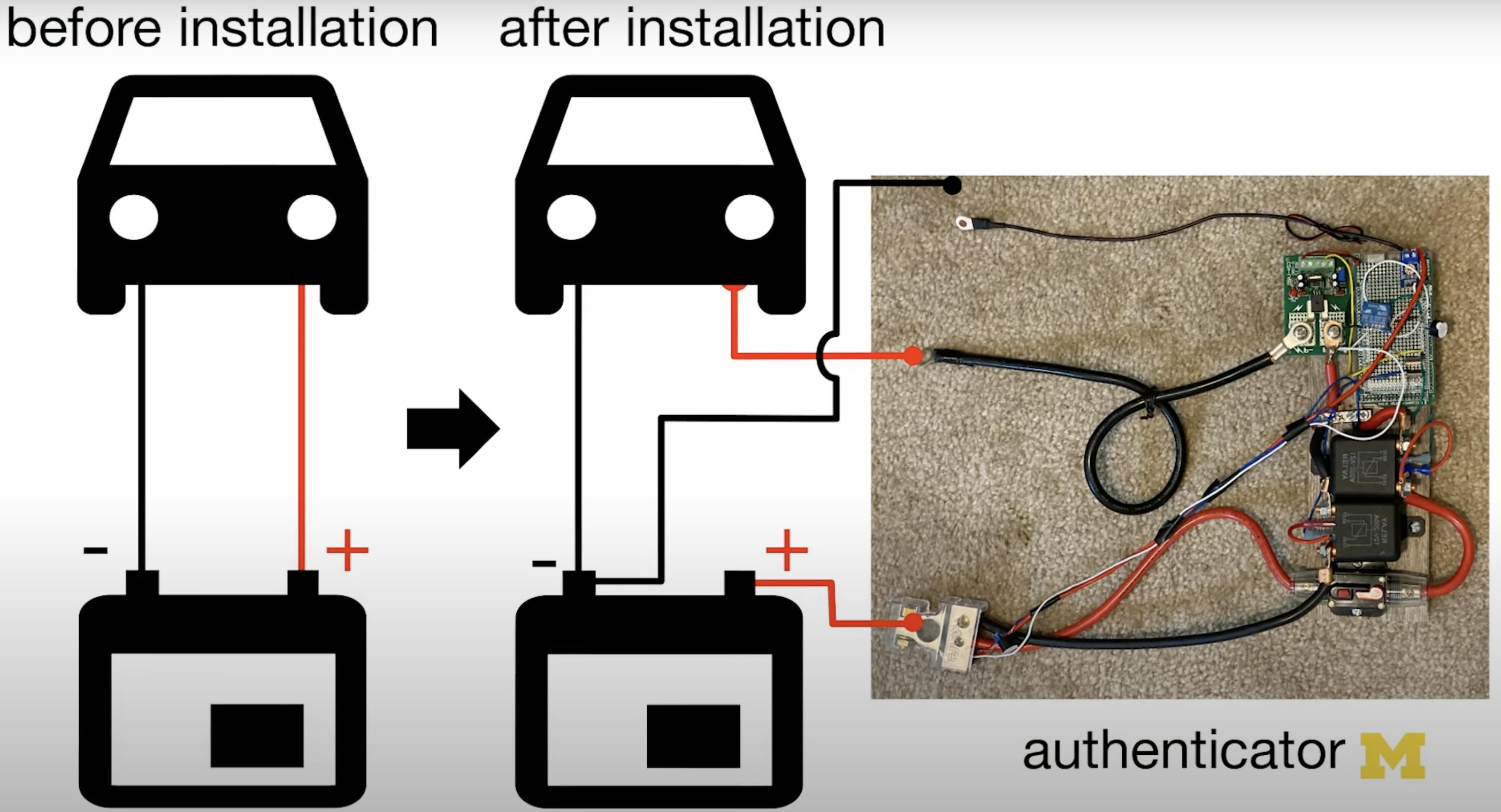Team at University of Michigan working on super-simple theft deterrent
With a $1.2 million grant from the National Science Foundation, a University of Michigan (U.M.) research team is set to begin large-scale testing of Battery Sleuth, a vehicle security system that can protect against “sophisticated wireless hacking, old-school jimmying, and everything in between.”
It’s so simple, you wonder why no one has thought of it before.
Using the auxiliary power outlet, known to those of a certain age as the cigarette lighter, Battery Sleuth bypasses both the wireless communication that key fobs depend on and the standardized onboard communication network that’s used in today’s vehicles. Instead, it authenticates drivers by measuring voltage fluctuations in a vehicle’s electrical system. Drivers interact with it through a keypad device plugged into the auxiliary power outlet.

“The great thing about the power outlet is its simplicity—it’s just a wire connected to the battery, so there’s nothing to hack,” said Kang Shin, the Kevin and Nancy O’Connor Professor of Computer Science at U.M. and lead researcher on the project. “And creating voltage fluctuations with components like windshield wipers or door locks is even simpler.”
Battery Sleuth delivers a predetermined series of voltage fluctuations—a sort of “voltage fingerprint,” the school says—to the car’s electrical system when the driver enters a numerical code into the keypad device. A receiver then recognizes this fingerprint and enables the vehicle to start. Drivers can also deliver the voltage fluctuation manually using auxiliary functions that draw battery power. They might perform some combination of flicking the windshield wipers, turn signal, or headlights on and off, or locking and unlocking the doors.
Installed between a vehicle’s battery and the car’s electrical system, Battery Sleuth’s default mode allows the battery to deliver enough current to power systems like electronics and lights, but not enough to power the vehicle’s starter. Only when it detects the pre-set series of voltage fluctuations in the vehicle’s electrical system does it turn up the juice, allowing the battery’s full power through to the starter.

“The idea of measuring fluctuations in a car’s electrical system seems simple, but designing one device that can do it accurately on thousands of different vehicle models in varying environmental conditions gets quite complicated,” said Liang He, assistant professor of computer science and engineering at the University of Colorado, Denver and a researcher on the project. “We’re working to design a system that’s smart enough to measure the parameters of the vehicle it’s installed on and then customize itself to work effectively on that vehicle.”
The system is designed to work as either an add-on to existing vehicles or a permanently installed component on new vehicles. “Vehicle theft costs drivers and insurance companies more than $4 billion each year in the United States alone, and that’s partly because today’s vehicles use a hodge-podge of computer systems that were never designed to work together,” Shin said. “Each new layer of technology introduces new security vulnerabilities, and rather than try to patch each one, we’ve developed a system that works completely independently.”
***
Check out the Hagerty Media homepage so you don’t miss a single story, or better yet, bookmark it. To get our best stories delivered right to your inbox, subscribe to our newsletters.








Probably the simplest anti-theft device I ever saw was a device that locked between the floor and brake pedal so you can’t push the brake pedal down. The achilles heel of the steering wheel lock is that if you can’t cut the lock, you cut the steering wheel. You aren’t (easily) cutting through a brake pedal, and you certainly aren’t driving the car afterward if you do. Not sure why these never took off
Wouldn’t it have been easier, less costly, simpler and more reliable to have just kept the old school “pellet” keys and tumbler ignition like they still offer on less expensive models!?
Everytime car companies introduce new tech it feels like people are just being experimented on. Funny that now that manufacturers introduced this vulnerability using elaborate, complex and less reliable electronics guess what, there’s a fix that adds more electronics.
Average price of a new car today $48,000 but with this new feature $49,000. You didn’t think they would just give it away did you?
Hope you enjoy your new car and becoming a Beta Tester and all “secure” features that comes with…
Hy,
The old system your talking about only required a screw driver jabbed into the ignition (one with a square shaft) and a crescent wrench to turn the shaft hard this would strip any of the steering wheel locking component while also engaging the ignition in as little as 15 seconds after gaining enters with a slim Jim or a broken window the thief drives away with his paycheck (stolen car) delivered to his boss(the buyer) man with the paycheck (cash money) no reasonable thief would except a check to identify how he’s paid for stealing cars.
Not with the referenced ‘pellet’ or chip keys… it might crank, but if the proper key is not in the ignition, it will not start. I’m sure the car thieves with the laptop can get around this (and the U of M method), but the guy with the vice grip and flat tip is not getting away with the car
got a car with the first generation of gm’s key pellets, the pellet is actually just a resistor, so the first time the car gets started after manufacturing the system hardcodes the resistance, if someone rips out the ignition switch and trying to start the car they get nothing, unless they introduce a resistor of the same resistance into the circuit, there’s also about a 5 minute reset on the system if tripped.
accept
I wonder just how long it will take car thieves to figure out a way to over ride the voltage print of the anti-theft device with something as simple as a transformer used to increase the voltage of a DC Size D battery to burn out the circuitry of the anti-theft device then use their own device to reset a new anti-theft device that only they know the code (the more simple the better) use it and drive away to sell their ill gotten high dollar cars on demand to waiting customers who are more than willing to pay 3/4 or 1/2 of original price just to get their dream car with a different paint job and Vin number of course.
I suspect a jumper cable from the starter post to the battery would do the trick given how the system works
Nice security system. Thanks for the detailed photo showing how you can easily bypass it with a jumper cable. Glad to see my tax dollars are being so well spent at this state funded university.
Best one I ever found was a magnet was placed on the dash to connect the ignition wire so the car would start. Few criminals are going to take time to look for it.
On Older cars pull a coil wire as few will look and few will take a plug wire to drive away in 7 cylinders.
Many people over think these issues.
Assuming that a determined thief can jimmy the hood, then
“do we cut the blue wire or the red wire?”
Anything invented by man can be fixed (or hacked) by man. This system is indeed simple, but it’s not foolproof and nothing ever will be. Some will joke about the best anti-theft device is a manual transmission, which has some truth to it, I’m sure. But at my house, the best vehicle theft deterrent is to have junky cars that nobody else wants and that have no value to justify the time it would take to steal them. 😁
Around here those are the ones the teenagers target for joy rides. They have no intention on stealing them for profit. Just for kicks. Then they leave them abandon in a ditch or wrapped around a tree. Ask me how I know…
Yes, I always park by a better car so that I would not be the first choice. I have also added secret ignition grounding switches or fuel pump shut-off switches for when I think that my car would be a target (parking in rough places).
Robert Blake said in an interview:There’s two ways to seal a car you drive it away or you tow it away. some form of ignition interrupt is the easiest way to avoid drive away. Fuel system cut off very effective to but more cumbersome to operate.I favor a kill switch, interrupting power to the ignition system. Easy to hide the wiring where it can’t be found easily. We installed these on our 43 Willys jeep and our 60s Pontiac’s and Chevrolets .Most thieves will not try to hotwire a car nowadays. The object is to slow the thief down and force him to pick lower hanging fruit. I see GTA similar to horse theft in the 19th century. It is a hanging offense!
I had 2 ignition cut-off switches mounted under the dash in my 1969 Roadrunner. Three theft attempts, none successful.
I need a battery sleuth to determine why I have intermittent no start after replacing the battery once and the alternator twice…my mechanic says battery has 1200 amps and alternator has 13.75 volts, but the car is 20 years old with 175,000 miles so I just assume pay somebody to drive it to the auto gobbler right about now…
It’s interesting but I figure it could be bypassed somehow.
I remove the distributor rotor and hide it or take it with me. Yes, they can tow the car away but at least they won’t start it.
Seriously? Your statement makes me wonder what kind of car are you driving, where do you live, what do you do with the rotor if you are on a date (Ask her to stash it her purse?), how do you clean your hands after removal, etc, etc. Inquiring minds want to know!
Seems way over complicated to add basically a combination lock on the starter. Hidden fuel pump switch could be done without a million dollar grant.
Open garage door. Place car in garage. Close garage door.
Lock it.
Cant steal what they cant access.
There is always the analog approach. Just elevate the vehicle and tow it off. Once in the clutches of the evil one, anything can be neutered. Real security is a function of the number and variety of barriers as well as their sophistication. This could be a valuable component in such a strategy. Good innovation.
I think the “old school” method of using the $5 device you can buy that is basically a switch between the positive battery post and the positive battery cable does the same thing. Both of these can be defeated by “popping the hood”, and disabling the device. At least the “old school” method only costs $5 for the same protection…